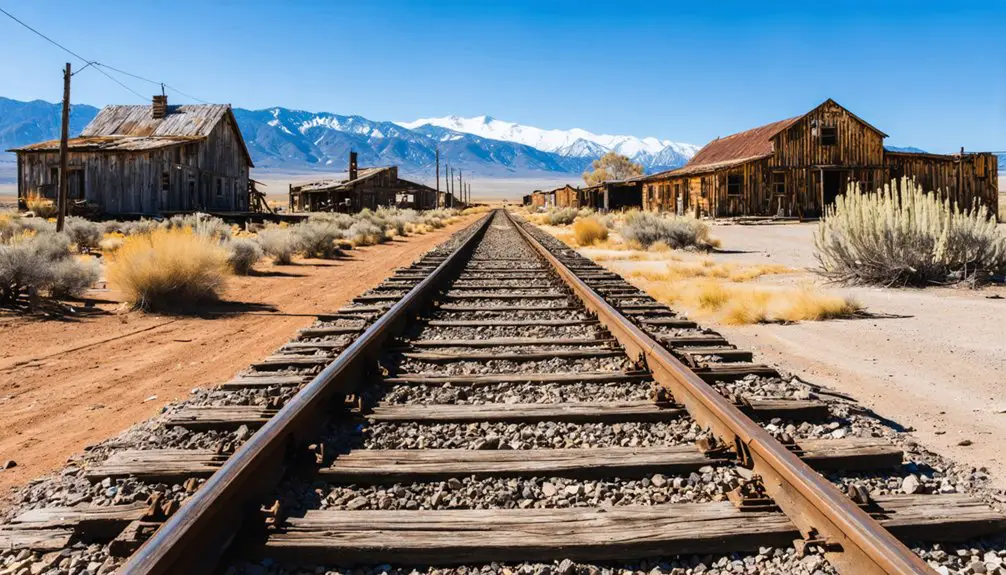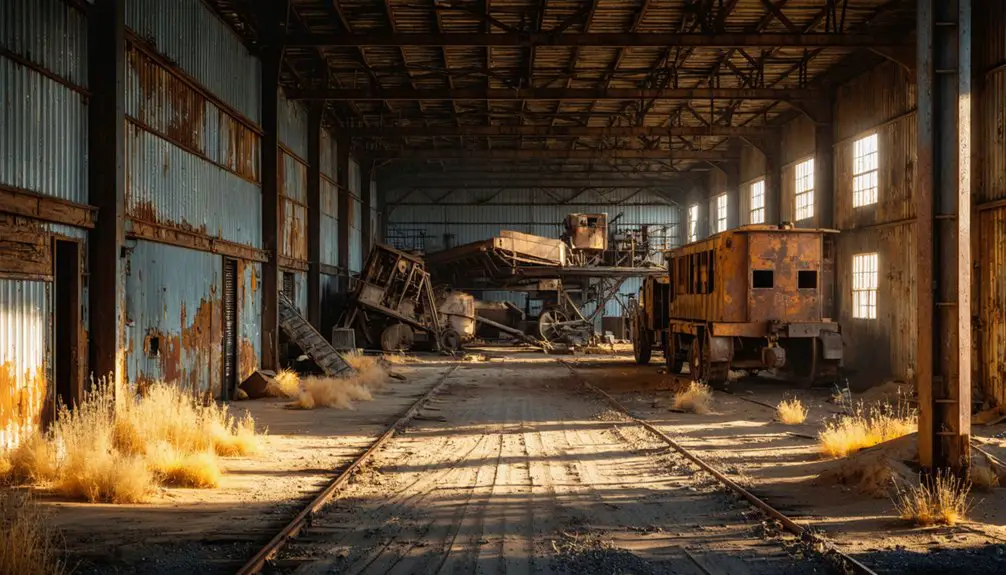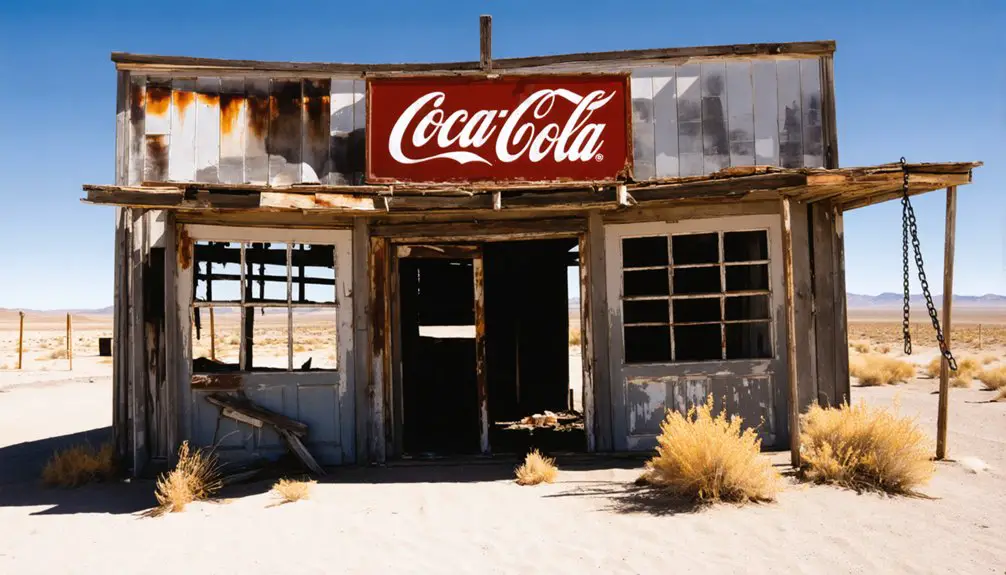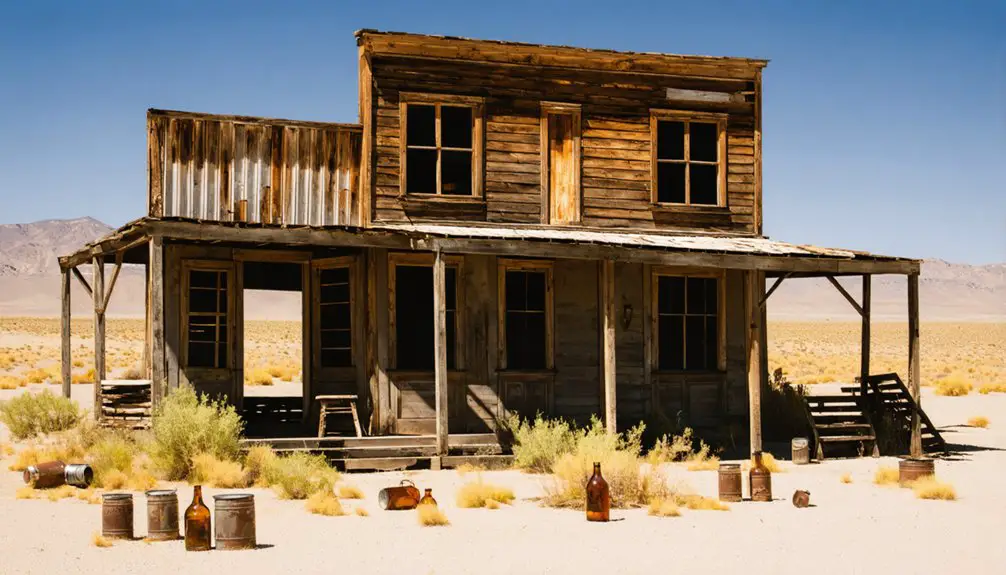You’ll find White Plains ghost town in Churchill County, Nevada, where it thrived in the late 1860s as a mining and salt production center. The Central Pacific Railroad established a strategic station here in 1868, transforming transport costs to one-tenth of traditional methods. The Desert Crystal Salt Company processed 200 tons annually, while nearby silver mines flourished. The town’s alkali flats and limestone ruins tell a deeper story of Nevada’s industrial frontier.
Key Takeaways
- Established in 1864 as a silver ore processing site, White Plains later transitioned to salt production through the Desert Crystal Salt Company.
- The Central Pacific Railroad established a station in 1868, making White Plains a vital transportation hub for mining operations.
- The community produced 200 tons of salt annually but struggled with resource depletion and harsh desert conditions.
- Essential services included a post office and telegraph station from 1879-1909, supporting the industrial operations.
- Mining activity declined by 1873 due to ore depletion and fires, contributing to the area’s eventual abandonment.
Geographic Setting and Natural Features
Nestled in Churchill County, Nevada, White Plains sits among vast alkali flats that gave the ghost town its namesake.
You’ll find this desert settlement near the historic Truckee River Route of the California Trail and the Central Pacific Transcontinental Railroad, positioned close to the significant Humboldt Sink and 40 Mile Desert landmarks.
The geological features surrounding White Plains showcase broad salt flats and limestone deposits, while environmental challenges include extreme temperature swings and minimal rainfall typical of the Great Basin. Much like its New York counterpart located 33 miles north of Manhattan, this White Plains occupies a distinctive geographical position.
You’re looking at an arid landscape shaped by wind erosion and weathering, where sparse vegetation clings to alkaline soils. Like the vast desert stretches near Ward, the isolation creates an eerie, untouched atmosphere.
The area’s deep water table and ephemeral streams reflect the harsh desert basin topography, with mineral-rich evaporite deposits telling the story of ancient lake beds.
Early Settlement and Pioneer Life
While White Plains never gained direct railroad access, the settlement’s early pioneers established themselves in 1864 to process silver ore from nearby mines before shifting to salt production.
You’ll find that by the early 1870s, the Desert Crystal Salt Company had built a solar evaporation plant, processing approximately 200 tons of salt annually for eastern Nevada’s silver mining regions.
The community’s initial growth centered around these salt operations, with essential services like the post office and telegraph station being established by 1879. Like many boom-and-bust mining towns, White Plains struggled when resources became depleted. Due to frequent confusion with similarly named locations, many historical records required place name disambiguation to accurately track White Plains’ development.
Railroad’s Impact on Settlement
As the Central Pacific Railroad carved its path across Nevada in 1868, White Plains emerged as a strategic station along the newly constructed transcontinental route. The railroad expansion transformed this remote desert location into a hub of activity, drawing settlers and workers who established critical infrastructure for both industrial and residential needs. The railroad’s ability to reduce transport costs to one-tenth of traditional methods revolutionized the economics of the region.
You’ll find that the railroad’s presence was instrumental in supporting the region’s emerging salt mining operations, particularly Walter Schmidt’s enterprise. The establishment of regular rail service meant you could now transport goods, equipment, and supplies more efficiently than ever before. The Desert Crystal Salt Company produced 200 tons annually during its peak operations.
Despite the harsh desert conditions and scarcity of resources, the railroad fostered settlement patterns that brought essential services to the area, including postal facilities and trade centers, forever changing the dynamics of pioneer life in this corner of Nevada.
Early Salt Mining Community
The original pioneers of White Plains encountered a stark yet promising landscape when they first crossed the alkaline flats in the 1840s along the Truckee River Route.
While initial silver mining attempts failed due to scarce water and fuel, the discovery of rich salt deposits in 1870 transformed the settlement’s destiny. Under Walter Schmidt’s leadership, the Desert Crystal Salt Company pioneered salt extraction through solar evaporation, establishing two major processing sites.
You’ll find the pioneer economy centered around producing 200 tons of salt annually, primarily supporting Nevada’s silver mining districts. The community grew to include essential services like a post office and telegraph station by 1879.
Despite harsh desert conditions, settlers built homes and stables near the evaporator sites, adapting to the seasonal rhythms of salt production.
Mining Ventures and Silver Processing
Following the discovery of silver on White Pine Mountain‘s western slopes in 1865, mining ventures rapidly transformed the region into a bustling hub of extraction and processing activity.
Mining techniques evolved as prospectors tackled the unique challenges of Treasure Hill’s ore deposits, which contained rich veins of silver oxide in brecciated limestone. The region attracted numerous skilled Californians who brought their gold mining expertise to these new silver districts. You’d find 11 mills operating in the area by 1867, processing ore through advanced amalgamation methods that defined Nevada’s mining heritage.
- The Eberhardt Mine yielded an extraordinary six-ton mass containing rare grayish-green crystals
- Ore extraction focused on shallow deposits rather than extensive veins, limiting long-term sustainability
- Nearly 200 mining companies incorporated during the peak, showing remarkable investment confidence
- Processing mills combined rich ore with waste rock to optimize silver recovery through amalgamation
The area’s mining success was short-lived, as ore depletion and devastating fires led to a significant decline in production by 1873.
Salt Production and Desert Crystal Salt Company
While silver mining dominated White Plains’ early economy, another valuable mineral enterprise emerged when Walter Schmidt founded the Desert Crystal Salt Company in 1870.
The company established two strategic evaporator sites: one near future Huxley and another southwest of White Plains. Through efficient salt harvesting and evaporation techniques, they’d process roughly 200 tons annually, shipping directly to eastern Nevada’s silver mills via the Central Pacific Railroad. Similar to Utah operations, they collected salt during the harvest season from September to April.
You’ll find the operation was well-planned, with a salt mill, house, and stable supporting the main site. The operation relied on brine from salt springs to fill their surface evaporation vats.
While facing challenges like fuel and water scarcity, the company persisted through various arrangements, including a 1911 lease to International Salt Company.
The enterprise reflected the region’s resourcefulness, transforming White Plains’ alkali flats into a vital supply source for Nevada’s mining industry.
Railroad Development and Transportation

As transcontinental ambitions pushed westward, Central Pacific Railroad crews reached White Plains in 1868, establishing a strategic station along Nevada’s challenging desert route.
You’ll find this period marked by intense railroad expansion, with Chinese laborers making up 80-90% of the workforce who conquered the harsh terrain. The station’s transportation logistics proved essential for the region’s salt operations and connected White Plains to major mining districts through the Virginia & Truckee Railroad’s later extension to Reno.
- Chinese workers overcame hazardous conditions to blast through granite mountains
- Water stations were positioned every 10 miles for steam locomotive refueling
- The V&T Railroad connection increased daily train frequency to 36-45 trips
- Regional rail lines fostered economic growth for remote Nevada settlements
Community Services and Daily Life
The daily life in White Plains revolved primarily around its industrial operations, with limited community services reflecting its transient nature.
You’d find basic amenities centered around the post office and telegraph service, which operated from 1879 to 1909, providing essential communication links to the outside world.
Community interaction was largely shaped by economic challenges, with workers focusing on silver milling and salt processing operations.
While you wouldn’t find schools or medical facilities in town, the nearby settlements helped fill these gaps.
The town’s infrastructure remained sparse, with water and fuel shortages affecting daily operations.
Most residents were male workers who relied on basic commercial services, though records don’t detail specific businesses.
The telegraph office served as a crucial hub for coordinating shipments and maintaining connections with regional mining districts.
Industrial Infrastructure and Facilities

You’ll find White Plains’s industrial backbone centered around its salt processing facilities, including two Desert Crystal Salt Company evaporation plants that produced 200 tons of salt during the 1870s.
The town’s strategic position as a Central Pacific Railroad station, established around 1868, made it an essential transport hub for shipping salt and mining materials from the surrounding region.
Supporting infrastructure included multiple processing buildings, worker housing, and stables that served both the salt works and nearby mining operations.
Salt Processing Operations
Salt processing infrastructure at White Plains expanded considerably after 1870, when Walter Schmidt’s Desert Crystal Salt Company established evaporation plants near the settlement.
You’ll find the operation’s industrial significance reflected in its annual output of 200 tons, which primarily served eastern Nevada’s silver mining districts. The company’s salt evaporation technology relied on strategically placed evaporator sets southeast and southwest of White Plains, maximizing the area’s natural desert conditions.
- A house, stable, and salt mill formed the core processing complex
- Solar evaporation pans crystallized salt from natural brine
- Mills processed the harvested salt for wagon transport
- Rail spurs connected production sites to the Central Pacific Railroad
The processing facilities adapted to market demands, though water scarcity and energy constraints led to intermittent operations throughout their history.
Railroad Transport Hub
Establishing itself as a pivotal transport nexus, White Plains station emerged on the Central Pacific Railroad line in 1868, connecting Nevada’s mineral-rich interior with national markets.
The station’s strategic location spurred rapid railroad expansion, as both the Nevada Northern Railway and Western Pacific Railroad established essential links by 1909.
You’ll find evidence of extensive freight logistics infrastructure that once dominated the landscape – from loading platforms and maintenance facilities to specialized sidings designed for mining operations.
The rail yard buzzed with activity as trains hauled copper ore, salt, lumber, and industrial supplies.
White Plains served as a significant transfer point where wagon-delivered goods from local industries reached the national rail network, transforming this remote desert outpost into a thriving hub of commercial activity.
Mining Support Buildings
Beyond the railroad infrastructure, White Plains’ industrial landscape featured an extensive network of mining support buildings that defined the town’s operational core.
You’ll find remnants of wooden processing facilities, including ore chutes and stamp mills that once crushed valuable minerals. The town’s mining infrastructure included crucial boiler houses that powered the machinery, though these facilities posed significant safety hazards due to explosion risks.
Worker housing and administrative buildings dotted the landscape, with most structures built primarily from wood due to its availability and cost-effectiveness.
- Processing facilities were crucial to the town’s mining operations, featuring stamp mills and concentrators for mineral extraction
- Wooden structures dominated the industrial landscape, though many were later salvaged or dismantled
- Administrative buildings and worker housing supported the mining community’s daily operations
- Safety concerns shaped facility design and placement, particularly around boiler houses and steep terrain
Decline and Abandonment

Despite initial promise as a mineral processing hub, White Plains began its steady decline in the late 1800s due to a perfect storm of challenges.
The town’s remote location and lack of reliable water sources made it increasingly difficult to sustain mining operations. Economic shifts favored better-connected mining towns with rail access, while White Plains remained isolated and technologically outdated.
Population trends reflected these hardships, as residents departed for more promising opportunities elsewhere.
Historical Legacy and Preservation
While the physical remnants of White Plains have largely faded into the Nevada desert, its historical legacy endures through careful preservation efforts and legal protections.
You’ll find that White Plains, established in 1864, represents a significant chapter in Nevada’s mining history, from its silver processing origins to its later salt production era.
Today, preservation efforts protect this historical significance through federal and state laws, volunteer monitoring, and educational programs that teach responsible site visitation.
– The Desert Crystal Salt Company’s 200-ton production in the 1870s showcases the site’s economic importance
- Trail cameras and volunteer patrols help prevent looting and maintain site integrity
- “Take only photographs, leave only footprints” policies protect artifacts for future generations
- Local historical organizations coordinate with authorities to provide interpretive tours and educational activities
- https://en.wikipedia.org/wiki/White_Plains
- https://nvtami.com/2024/07/23/ely-explorations/
- https://www.visittheusa.com/experience/6-nevada-ghost-towns-explore-if-you-dare
- https://www.nvexpeditions.com/churchill/huxley.php
- https://nvtami.com/white-pine-county-nevada-ghost-towns/
- https://www.wikiwand.com/en/map/White Plains
- https://www.homestratosphere.com/secluded-towns-in-the-white-pine-range/
- http://www.expeditionutah.com/forum/index.php?threads/ghost-town-eberhardt-white-pine-county-nevada.8148/
- https://en.wikipedia.org/wiki/List_of_ghost_towns_in_Nevada
- https://nevadamagazine.com/issue/winter-2024-2025/25048/
Frequently Asked Questions
Were There Any Notable Conflicts With Native American Tribes in White Plains?
As you gaze across the rugged desert landscape, you won’t find records of major Native American conflicts here. While land disputes and cultural exchanges occurred regionally, no notable battles happened at this specific location.
What Was the Highest Recorded Population of White Plains During Its Peak?
You won’t find an exact peak population recorded, but given the mining industry’s limited scope and early population decline, historical evidence suggests White Plains likely never exceeded 500 residents.
Did Any Famous Historical Figures Ever Visit or Stay in White Plains?
Like footprints in shifting desert sands, there’s no trace of famous visitors in White Plains’ history. You won’t find records of any notable historical figures staying in this remote mining outpost.
What Happened to the Salt Processing Equipment After the Town Was Abandoned?
You’ll find the salt machinery fate followed typical patterns: equipment decayed naturally, was stripped for parts, or got dismantled when rail connections ended. Most pieces were likely sold or scrapped.
Were There Any Schools or Churches Established During White Plains’ Active Years?
You won’t find any school establishments or church activities in the records – there’s absolutely no evidence of formal educational or religious institutions during White Plains’ brief industrial period.



